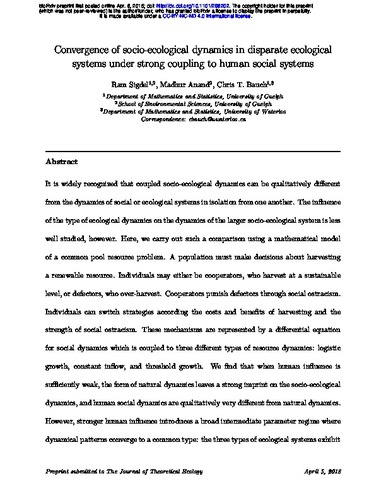UWSpace will be migrating to a new version of its software from July 29th to August 1st. UWSpace will be offline for all UW community members during this time.
Convergence of socio-ecological dynamics in disparate ecological systems under strong coupling to human social systems
| dc.contributor.author | Sigdel, Ram P. | |
| dc.contributor.author | Anand, Madhur | |
| dc.contributor.author | Bauch, Chris T. | |
| dc.date.accessioned | 2018-09-24 14:18:59 (GMT) | |
| dc.date.available | 2018-09-24 14:18:59 (GMT) | |
| dc.date.issued | 2018-04-06 | |
| dc.identifier.uri | https://doi.org/10.1101/296202 | |
| dc.identifier.uri | http://hdl.handle.net/10012/13907 | |
| dc.description | bioRxiv preprint first posted online Apr. 6, 2018; doi: http://dx.doi.org/10.1101/296202. The copyright holder for this preprint (which was not peer-reviewed) is the author/funder, who has granted bioRxiv a license to display the preprint in perpetuity. It is made available under a CC-BY-NC-ND 4.0 International license. | en |
| dc.description.abstract | It is widely recognized that coupled socio-ecological dynamics can be qualitatively different from the dynamics of social or ecological systems in isolation from one another. The influence of the type of ecological dynamics on the dynamics of the larger socio-ecological system is less well studied, however. Here, we carry out such a comparison using a mathematical model of a common pool resource problem. A population must make decisions about harvesting a renewable resource. Individuals may either be cooperators, who harvest at a sustainable level, or defectors, who over-harvest. Cooperators punish defectors through social ostracism. Individuals can switch strategies according the costs and benefits of harvesting and the strength of social ostracism. These mechanisms are represented by a differential equation for social dynamics which is coupled to three different types of resource dynamics: logistic growth, constant inflow, and threshold growth. We find that when human influence is sufficiently weak, the form of natural dynamics leaves a strong imprint on the socio-ecological dynamics, and human social dynamics are qualitatively very different from natural dynamics. However, stronger human influence introduces a broad intermediate parameter regime where dynamical patterns converge to a common type: the three types of ecological systems exhibit similar dynamics, but also, social and ecological dynamics strongly mirror one another. This is a consequence of stronger coupling and is reminiscent of synchrony from other fields, such as the classic problem of coupled oscillators in physics. Socio-ecological convergence has implications for how we understand and manage complex socio-ecological systems. In an era of growing human influence on ecological systems, further empirical and theoretical work is required to determine whether socio-ecological convergence is present in real systems. | en |
| dc.language.iso | en | en |
| dc.rights | Attribution-NonCommercial-NoDerivatives 4.0 International | * |
| dc.rights.uri | http://creativecommons.org/licenses/by-nc-nd/4.0/ | * |
| dc.subject | common-pool resources | en |
| dc.subject | cooperative harvesting | en |
| dc.subject | social ostracism | en |
| dc.subject | human-environment systems | en |
| dc.subject | socio-ecological convergence | en |
| dc.subject | evolutionary game theory | en |
| dc.title | Convergence of socio-ecological dynamics in disparate ecological systems under strong coupling to human social systems | en |
| dc.type | Preprint | en |
| dcterms.bibliographicCitation | Sigdel, R., Anand, M., & Bauch, C. (2018). Convergence of socio-ecological dynamics in disparate ecological systems under strong coupling to human social systems. BioRxiv, 296202. https://doi.org/10.1101/296202 | en |
| uws.contributor.affiliation1 | Faculty of Mathematics | en |
| uws.contributor.affiliation2 | Applied Mathematics | en |
| uws.typeOfResource | Text | en |
| uws.peerReviewStatus | Unreviewed | en |
| uws.scholarLevel | Faculty | en |


